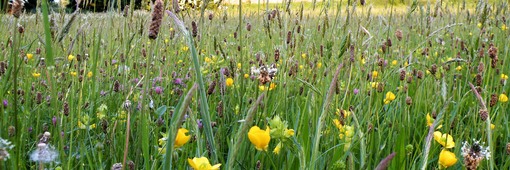

Biodiversity
Action
Plan
Conservation. Species-rich Neutral Grassland sites in Barnsley are small in area, localised and fragmented; with many lost or declining in condition: Neutral Grassland is a priority for conservation.
Factors causing loss or decline
- Change of use of grassland by ploughing for arable crops, or shift to silage production with grass taken earlier in the year.
- Drainage, enrichment, herbicide and pesticide use, and re-seeding with nutrient-demanding rye-grass crops, poor in biodiversity.
- Over-grazing and compaction of grassland by livestock overstocking.
- Rush, bracken and scrub encroachment and rank overgrowth.
- Loss of grassland sites due to housing, industrial and recreational development or use for tree planting / woodland creation.
- Inappropriate management in urban areas, with grasslands being intensively mowed, planted with non-native plants, and ‘tidied up’.
- Loss of unimproved or semi-improved grassland and fragmentation of the remaining grassland habitat putting wildlife species at risk.
Legal protection
In Barnsley the Lowland Meadow / Neutral Grassland SSSIs have legal protection..
Neutral Grassland sites in Local Wildlife Sites have a presumption against development or change of use if planning consent is required.
Specific wildlife species are protected under the Wildlife and Countryside Act. This includes intentionally or recklessly disturbing birds at, on or near an ‘active’ nest.
Defra Ecological Impact Assessments may apply to species-rich grasslands.
Links for advice and information
Magnificent Meadows: Guidance
RSPB: Grassland management for birds
Buglife: Grassland management
NE: Assessing grassland priority habitat
Good management practice for biodiversity:
Maintaining or returning to traditional low-intensity farming of semi-natural unimproved or semi-improved grassland.
- Avoiding ploughing and reseeding of pastures and meadows, except for restoration to semi-natural grassland.
- Reducing or eliminating the use of artificial fertilisers and herbicides.
- Mowing meadows for hay or silage from late July (at the earliest) to September to allow wild flower seeds to fall.
- Maintaining diversity of structure by aftermath & seasonal grazing
- Leaving some areas unmown, untopped or with lighter grazing; maintaining longer grass in less productive fields or field margins.
In addition
- Maintaining damp pasture and flushes
- Controlling rush, bracken and scrub encroachment and rank overgrowth
- Maintaining areas of wildflowers. Scarifying and spreading green hay or seeds of local provenance to get more species diversity.
- Avoiding muck spreading, rolling, topping and harrowing in fields with ground breeding birds from April to July.
* Other indicators of favourable condition may include ≥ 10 cm height of sward in June/July; < 10% rye grasses and white clover; < 10% tall grasses; < 25% plant debris litter layer
Neutral Grassland BAP priority habitat in favourable condition* is denoted by:
≥ 2 frequent/2 occasional Lowland Meadow indicator species or ≥ 1 frequent floodplain meadow indicator species and 3 occasional indicator species in floodplain meadows
≥ 20% cover of wildflowers and sedges excluding undesirable species (below), creeping buttercup and white clover
< 5% undesirable species eg dock, nettle, thistle, ragwort, cow parsley,bracken,
< 5% cover of invasive trees and scrub
< 30% indicators of water logging - rushes,reeds, large sedges etc
< 10% extent of bare ground *
From Farm Environment Plan guidance


Neutral Grassland Conservation
The best form of management is ‘cut and remove’ in late summer – preferably as a hay crop.
This maintains a lower level of fertility that benefits herb species.
Grazing after cutting in autumn and very early spring encourages plant diversity in meadows.
See also guidance and requirements
for Countryside Stewardship and
New Environmental Land Management Schemes